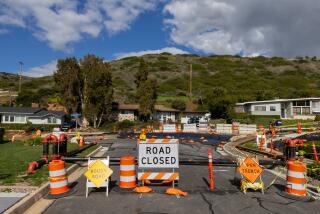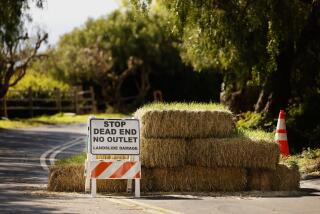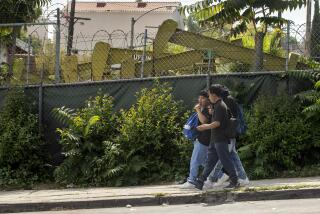How much damage is the Porter Ranch leak doing to the climate?
Stephen Conley has flown pollution-detecting airplanes over some of the largest oil and gas fields in the nation. But never before has the UC Davis scientist encountered as much methane in the air as in recent months over suburban Los Angeles.
Over and over, Conley has flown his single-engine plane through the invisible plume billowing from an underground natural gas storage facility and into Porter Ranch to provide California air quality officials estimates of the planet-warming emissions from the leak.
On the first flight, in November, methane levels above the community jumped to 50 parts per million, so high that Conley double-checked his instruments in disbelief.
“This is probably 20 times bigger than anything else we’ve measured,” Conley said.
In three months, one failed well at Southern California Gas Co.’s Aliso Canyon storage field has spewed more greenhouse gases than any other facility in California. At its height, the leak more than doubled the methane emissions of the entire Los Angeles Basin and surpassed what is released by all industrial activity in the state.
Experts say the release of so much methane, a fast-acting greenhouse gas many times more powerful than carbon dioxide, means that the biggest environmental consequence of the leak will be its effect in boosting global warming. Long after the leak stops and the foul odors vanish, the pulse of methane will remain in the atmosphere and its damage to the climate will go on.
State regulators and scientists studying the leak warn that the longer the gas escapes into the air, the more it will work against California’s progress fighting climate change, including the target announced by Gov. Jerry Brown last year to reduce emissions of methane and other short-lived climate pollutants by 40% or more by the year 2030.
“It’s really moving us in the wrong direction,” said Jorn Herner, chief of research planning, administration and emissions mitigation at the state Air Resources Board.
Once the leak is stopped, air quality officials plan to complete a detailed estimate of its methane emissions using computer models and data from a network of gas analyzers on towers and buildings throughout the region. It will take months to complete an accurate measurement.
Until then, Conley’s measurements, though considered rough estimates, are the best indication of the climate effects from the ongoing leak. They are taken about once a week and paid for by the gas company.
If there is any good news, it is that they show the leak rate has been declining since its peak on Nov. 28, when the well released 58,000 kilograms of methane per hour. By Thursday the rate had dropped by two-thirds to 18,400 kilograms per hour.
The utility attributed the decline to its increased withdrawals of gas from the underground reservoir, “which is helping reduce the pressure that is pushing the gas up the well and out of the leak,” gas company spokeswoman Kristine Lloyd said in an email.
As a result, she said, the reservoir has gone from being 90% full before the leak to at most 37% full on Jan. 10.
The utility does not have an estimate of the amount of gas released and says it cannot complete one until after the leak has stopped.
Crews are drilling a relief well to seal off the damaged one, with work expected to be completed by late February. Earlier this month the gas company abandoned a plan to capture and burn the leaking methane after regulators raised concerns about safety and explosion risk.
The utility has pledged to make up for its harm to the climate.
Brown has ordered state officials to draft a plan for the gas company to offset the emissions by funding projects in California to curb fast-acting climate pollutants such as methane.
“Those are significant but reasonable constraints,” said Gary Gero, senior advisor to Climate Action Reserve, a leading certifier of carbon offsets. He said the emissions from the leak are so great that the gas company would have difficulty finding enough certified offsets to cover them.
The utility would not otherwise be required to pay for its pollution because California’s climate change regulations exempt methane leaks — even enormous ones — as “fugitive emissions” that are not subject to the state’s cap-and-trade program.
So far, estimates show the leak has put out the equivalent of 2.1 million metric tons of carbon dioxide — more greenhouse gas than 440,000 cars emit in a year. Because the surge of pollution is in the form of methane, it will have a more immediate heat-trapping effect on the atmosphere.
Natural gas consists mostly of methane. Health officials say mercaptan and other odorants added to the gas are responsible for the symptoms being reported by Porter Ranch residents, including headache and nausea. The gas also contains compounds such as benzene that can increase cancer risk through long-term exposure.
State regulators and scientists monitoring methane from the leak throughout the Los Angeles region emphasized the gas is not at concentrations that pose a health or safety risk to residents.
But its fingerprint is evident far and wide, said Riley Duren, a researcher at NASA’s Jet Propulsion Laboratory in La Cañada Flintridge. A network of gas-detecting instruments across the basin, including one sensor atop Mt. Wilson, has detected noticeable increases in methane levels as far away as Orange County and San Clemente Island, he said.
Duren thinks estimates gathered by airplane represent a “reasonable lower bound” and that total methane emissions from the leak could be higher.
The methane is leaking from one of 115 wells at the company’s sprawling facility in the Santa Susana Mountains, which stores natural gas for use across Southern California. With a capacity of 86 billion cubic feet, it’s one of the largest of more than 400 natural gas storage fields around the nation.
This is a massive leak, but it’s not altogether unexpected.
— Jessika Trancik, assistant professor of energy studies at Massachusetts Institute of Technology
The incident is likely to affect regulations under development by state and federal environmental agencies to reduce methane emissions from oil and gas operations.
“This is a massive leak, but it’s not altogether unexpected,” said Jessika Trancik, assistant professor of energy studies at Massachusetts Institute of Technology, who evaluates the climate effects of natural gas-related emissions.
That’s because of a growing recognition that the nation’s natural gas infrastructure is vulnerable to leaks and other failures, particularly as it ages, Trancik said.
“It’s inevitable that parts of the supply infrastructure will fail, but the impacts of these kinds of events can be contained if we have more comprehensive monitoring and better predictions of which sites are at risk,” she said.
Join the conversation on Facebook >>
Studies in recent years have found emissions in the industry are significantly underestimated by official inventories. Experts blame widespread leakage, with some estimating that between 2% and 4% of the natural gas in the nation escapes into the air at some point in the production, transmission and distribution system.
Companies have spent millions in recent years improving monitoring and tightening up equipment to reduce the risks to the climate and the public, said Rob Jackson, environmental scientist at Stanford University.
“One accident like this wipes out those benefits over the past year and more,” said Jackson, who is studying the Aliso Canyon leak and thinks it is probably one of the largest in the last 50 years.
State officials might have more quickly understood the severity of the leak if they had measured its emissions earlier. The first aerial measurements came more than two weeks after the leak was reported by the gas company on Oct. 23. The Air Resources Board said it wasn’t notified of the leak until Nov. 5.

UC Davis project scientist Stephen Conley measured methane emissions from the Aliso Canyon natural gas leak on Jan. 8, 2016.
Reports submitted to the state agency show that pilot Conley made his first attempt to measure emissions from the leak the same day, working for the advocacy group Environmental Defense Fund. But Conley was sent home.
“During the two-hour flight to the site at the northern edge of the Los Angeles metro area, EDF was dissuaded from the measurement by personnel from SoCal Gas, citing extreme danger,” according to a report by the pilot. Just before reaching the facility, the environmental group ordered him to turn around, Conley said.
Conley returned two days later, under contract with the state, to complete the first successful emissions measurements.
“That’s when we discovered this absurd level,” Conley said.
The Air Resources Board released its first estimate of the greenhouse gas emissions nearly two weeks later, after what officials called an extensive review of the data.
The agency’s Nov. 20 report found that the stricken well was boosting California’s methane emissions by about 25%, underscoring “the urgency of stopping the gas leak.”
Twitter: @tonybarboza
MORE ON PORTER RANCH
Businesses in Porter Ranch struggling as customers relocate
Gas company forced to resume offering rental houses to Porter Ranch families
Porter Ranch: Regulators approve comprehensive abatement order over massive gas leak







